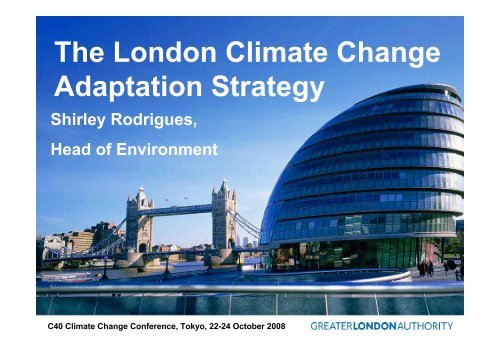The London Climate Change Adaptation Strategy
The London Climate Change Adaptation Strategy
The London Climate Change Adaptation Strategy
- No tags were found...
Create successful ePaper yourself
Turn your PDF publications into a flip-book with our unique Google optimized e-Paper software.
<strong>The</strong> <strong>London</strong> <strong>Climate</strong> <strong>Change</strong><br />
<strong>Adaptation</strong> <strong>Strategy</strong><br />
Shirley Rodrigues,<br />
Head of Environment<br />
C40 <strong>Climate</strong> <strong>Change</strong> Conference, Tokyo, 22-24 October 2008
Greater <strong>London</strong> Authority<br />
What is the GLA ?<br />
•Led by the Mayor of <strong>London</strong> Mayor’s Priorities<br />
•Citywide government for • Tackle climate change<br />
<strong>London</strong><br />
•GLA Group<br />
• <strong>London</strong> Development Agency<br />
• Transport for <strong>London</strong><br />
• Metropolitan Police Authority<br />
• <strong>London</strong> Fire and Emergency<br />
Planning Authority<br />
•Reduce <strong>London</strong>’s CO 2 emissions<br />
by 60% by 2025<br />
•Prepare <strong>London</strong> for climate<br />
change and extreme weather<br />
• Improve <strong>London</strong>’s environment<br />
and quality of life of <strong>London</strong>ers<br />
• Provide affordable, high quality<br />
housing<br />
• 50,000 new homes per year
Why produce an adaptation strategy ?<br />
• Some climate change is now<br />
inevitable<br />
• <strong>The</strong>se changes will mean an<br />
increasing risk of impacts on<br />
<strong>London</strong><br />
• Proactive measures are much<br />
cheaper and more effective than<br />
reactive measures<br />
• We are not very well adapted to<br />
our current climate<br />
• Requirement of the GLA ‘climate<br />
change duty’
Warmer, wetter winters and hotter,<br />
drier summers<br />
Summer 2050’s (high emissions)<br />
• +3ºC<br />
• - 30-40% rainfall<br />
Winter 2050’s (high emissions)<br />
• +1.5 - 2 3ºC<br />
• + 25-30% rainfall<br />
S t t<br />
Average summer temperatures
By 2050s, 2/3 summers will be‘heatwaves’<br />
Temperature anomaly ( o C)
<strong>Adaptation</strong> <strong>Strategy</strong> headlines<br />
• A catastrophic tidal flood of <strong>London</strong> is very unlikely<br />
• <strong>The</strong> risk of floods, droughts and heatwaves in <strong>London</strong><br />
will increase<br />
• In the short-medium term rising temperatures are likely<br />
to be beneficial to <strong>London</strong>ers’ health<br />
• Many of the adaptation measures are good for the<br />
quality of life of <strong>London</strong>ers and the <strong>London</strong> economy<br />
• <strong>London</strong> was not designed for the kind of weather we<br />
will experience in the future<br />
• <strong>London</strong>’s growth has the potential to increase the<br />
problem<br />
• <strong>The</strong> poorest in the city are most at risk<br />
• <strong>Adaptation</strong> is a dynamic process
When to adapt & how much to adapt to ?<br />
Proactive<br />
Reactive<br />
Prevention<br />
•Structural measures, land use planning,<br />
mitigation<br />
Preparedness<br />
•Vulnerability assessments, public awareness,<br />
insurance<br />
Response<br />
•Emergency plans, support for the vulnerable<br />
Recovery<br />
•Insurance claims support, temporary<br />
accommodation
<strong>London</strong> is already warming…..
<strong>London</strong>ers are vulnerable to high<br />
temperatures<br />
• 600 people died in 2003<br />
heatwave in <strong>London</strong><br />
• <strong>London</strong> had highest<br />
number of deaths<br />
• <strong>London</strong> did not have the<br />
highest temperatures<br />
• Older people most at risk
Urban heat island effect<br />
<strong>London</strong>’s microclimate<br />
amplifies the health impact<br />
of heatwaves (<strong>London</strong> is<br />
up to 10ºC warmer than<br />
the greenbelt on summer<br />
nights)
Temperatures are predicted to rise<br />
further…<br />
• <strong>London</strong> will experience an<br />
increasing risk of overheating<br />
due to:<br />
• Global warming induced climate<br />
change<br />
• <strong>The</strong> intensification of the Urban<br />
Heat Island (UHI) effect from:<br />
• climate change<br />
•increase in development density<br />
from <strong>London</strong>’s growth<br />
•increase in man-made heat<br />
contributions as a response to higher<br />
temperatures (eg air conditioning)<br />
and <strong>London</strong>’s growth<br />
•reduced evaporative cooling due to<br />
drier summers
Managing overheating in <strong>London</strong><br />
5 parallel courses of action<br />
• Managing <strong>London</strong>’s urban heat<br />
island<br />
• Designing new, and adapting<br />
existing buildings and infrastructure<br />
to minimise the need for cooling as<br />
far as possible<br />
• Ensuring that where cooling is still<br />
required, that low carbon, energy<br />
efficient methods are used<br />
• Enabling a cultural adaptation to<br />
high temperatures<br />
• Test, review and improve the<br />
heatwave plan
Urban greening programme<br />
Lead a city-wide programme to ‘green’ the <strong>London</strong><br />
to prevent the city from heating up<br />
• Use vegetation (street trees), greenspaces,<br />
greenroofs and greenwalls to cool the city and<br />
reduce flood risk<br />
• Identify flood and UHI ‘hotspots’ in <strong>London</strong><br />
• Prioritise measures in ‘hotspot’ areas and areas of<br />
social deprivation<br />
• Pilot greening examples to determine what greening<br />
measure works best in which circumstances<br />
• Develop city-wide programme<br />
• Note that we have developed a database of climate<br />
resilient tree species
Urban heat island action area<br />
Create an ‘urban heat island<br />
action area’ where new<br />
development must contribute<br />
to cooling the city<br />
•Ensure waste heat is not<br />
ejected into the street<br />
canyon<br />
•Contribute to local greening<br />
measures (inc greenroofs)<br />
•Use high albedo, low<br />
emissivity materials, eg<br />
coolroofs<br />
•Look at opportunities for<br />
district cooling
Supporting Guidance<br />
1. Provide <strong>London</strong>-specific design guidance to<br />
enable architects and engineers to reduce the risk of<br />
overheating in new development<br />
Currently UK building regs do not require developers to<br />
build for current (let alone future) hot summers<br />
2. Provide guidance on low-carbon cooling<br />
options<br />
•Compare and contrast cost, energy and carbon<br />
efficiency of different cooling technologies<br />
•Map district energy networks
Taking people with you…<br />
•Mayor cannot deliver <strong>Adaptation</strong> <strong>Strategy</strong> on his<br />
own<br />
•Need to consult with stakeholders and get<br />
commitment to delivery (<strong>London</strong> <strong>Climate</strong> <strong>Change</strong><br />
Partnership)<br />
•Work with existing programmes (don’t recreate<br />
the wheel or duplicate effort)<br />
•<strong>Adaptation</strong> is a dynamic process (what works<br />
today, won’t work forever)



